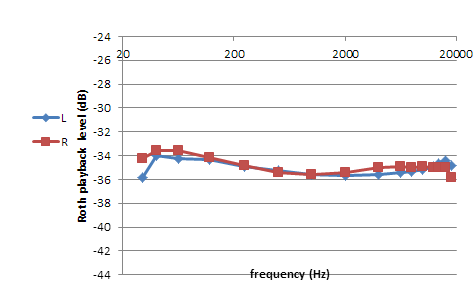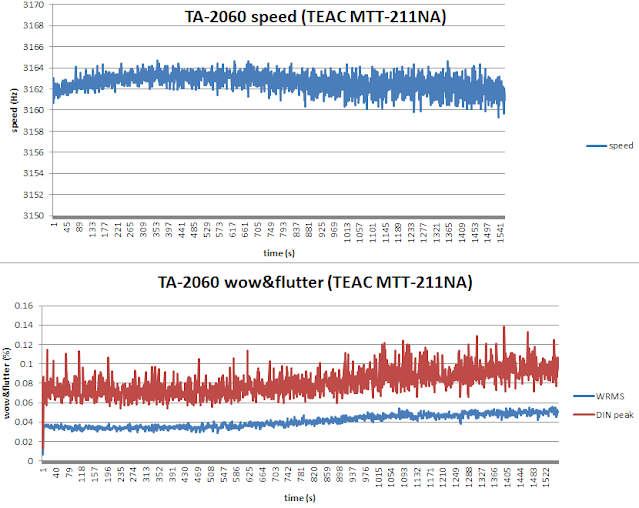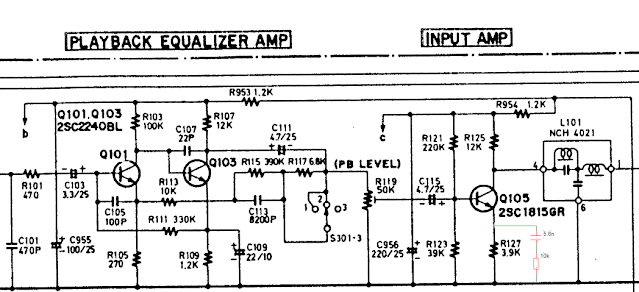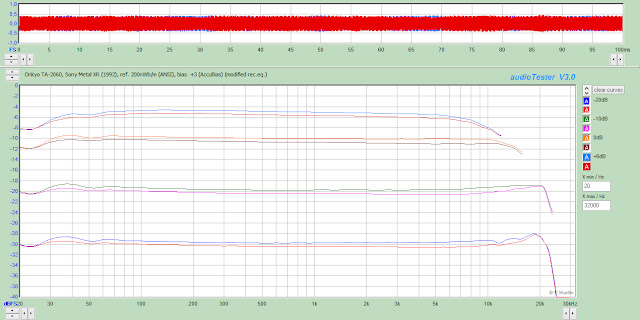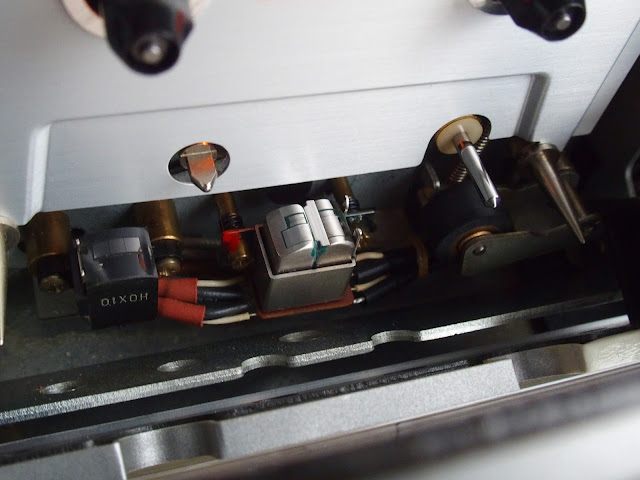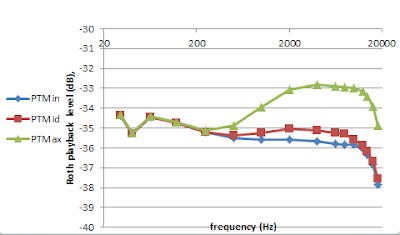When it comes to cassette decks one does not immediately think of NAD, right? Technological development, especially at the frenetic pace of the late 1970s and early 1980s, normally was the domain of the large, mostly Japanese, manufacturers. And yet, New Acoustic Dimension has had its share of firsts, such as the 6150C pioneering Dolby C in 1981.
In the period 1987-1989 NAD launched a triumvirate that always remained somewhat unique, these being the only decks ever that combined the Bang & Olufsen-invented Dolby HX Pro with Tandberg's Dyneq in a bid to solve one of cassette's most obvious problems: treble saturation. The low speed and high noise of cassette demands that treble be 'forced' onto the tape with aggressive record equalising boost. This pushes the treble signal close to, and over, the tape's limit, leading to self-erasure and thus squashed treble dynamics, a problem that is less severe at higher speeds such as 9.5 and 19 cm/s. Further, treble saturation grows worse with increased bias strength. Given that the actual bias applied to the tape is the sum of the bias signal and the high-frequency part of the music signal itself, it figures that the saturation level jumps up and down with the music, being the worst when this has the most negative effect. HX Pro sought to solve this, varying the bias signal inverse proportionally with the music signal, thereby keeping actual bias (more or less) constant.
Accompanying treble saturation is intermodulation distortion: strong treble applied to a tape in its saturation region generates sum and difference components, which materialise as anharmonic distortion in the midrange, muddling the sound. Tandberg Dyneq attacked this problem by wilfully reducing recording-time treble boost in the presence of treble peaks. True, this seems counter-productive in that it diminishes the level of the treble being laid down on tape, but at least intermodulation distortion is avoided.
HX Pro and Dyneq were combined in the NAD 6300 Monitor, 6100 Monitor, and 6340 decks. The 6300 was a top-of-the-line product, metal-cased, with three heads and the Sankyo double-capstan direct-drive mechanism famous from decks such as the Nakamichi CR-4/5/7, BX-300, and Onkyo TA-2070. The 6100 was a 6300-lookalike (but made from plastic), with a much simpler two-motor belt-drive transport, and two heads. The 6340 was essentially the same deck as the 6100, but in a more traditional NAD livery, with mechanical counter, and without remote control. Several versions of the 6100/6340 decks exist, assembled in Malaysia, Taiwan (ROC) or China (PRC). All of them have external bias control, the 'Car' dynamics compressor, as well as NAD's 'Play Trim' equaliser. The latter is a treble control situated before the Dolby decoder, helping reduce Dolby mistracking in case of worn tapes and/or azimuth incompatibility; Play Trim was also licensed to Yamaha and Uher.
Some people on forums like http://www.tapeheads.net attribute near-magical properties to these three NADs, enough to give them a try. I made my first acquaintance in medio-2018, with a 6100 Monitor, near-mint and complete with its remote control. I wanted to evaluate it specifically as a player for digitising a couple of 'difficult' Dolby C cassettes, including an XLI-S peaking at +14dB(!). After a transport service, mounting a generic new drive belt, and full realignment I was not overwhelmed: metal tape MOL was low, the replay frequency response showed a shelved-down treble (even with Play Trim at its maximum), and sound was slightly phasey and insubstantial. Ultimately a Nakamichi Cassette Deck 1 sounded quite a bit better on those tapes, and the 6100 was quickly sold.
Wondering what all the fuzz was about I lost interest in this family. Until in summer 2022 a defective 6340 crossed my path. For some reason I picked it up, paused my other restoration project (a nice Technics SL-7), and got to work.
The minimalistic, cheap, yet efficient mechanism was in disarray and partial disassembly due to the former owner's failed attempt at belt replacement. But luckily the microswitch hidden behind the head bridge raising wheel was still whole, even if slightly bent. The transport was taken apart, cleaned, lubricated, and reassembled with a new belt (from https://www.electro-andijk.nl). Replacing the belt involves splitting the mechanism and doing battle with a very finicky spring that has to grab a white lever (see first photo below), then wrap around its post and grab the backplate (second photo). Not fun. You also have to ensure that the control cam wheel is positioned correctly and goes through the right moves when the solenoid is activated: you can find (someone else's) movie of this here, you may want to look at it in slow motion. (Some people advocate not opening the mechanism at all, but rather slipping the belt between the back plate and the flywheel. This of course brings the risk of soiling the new belt with grease. Beware.) The microswitch was straightened out. I also deactivated the tape sensor switch, so that the deck could be operated without cassette, handy for test and debug. Speaking about ... the 6340 is not very friendly on the workbench: no headphone output, and a bathtub construction, i.e. without direct access to the board's solder side.
At this stage the mechanism worked, more or less, but winding was sloooow, and many tapes could not be played to their end. Continuing the service with the front-side of the transport it emerged that the reel hubs were as good as glued to their axles by dried-up grease. The pinch roller had visible scratches around its circumference and had to be replaced. (Remarkably that 6100 I once had suffered from exactly the same problem.) I also added a suppression capacitor to the reel motor, something that is normally present in every deck. After this it held speed well, but wow&flutter was a highish 0.09% WRMS. Spectral analysis in the T-100 app revealed this to be made up of mostly deep wow and high-frequency flutter, both with little direct audibility, even on piano music. Closer inspection of the roller revealed it had a bit of a wobble, i.e. eccentricity. A fresh roller from https://fixyouraudio.com/ cured this, bringing long-term averaged W&F down to less than 0.07% WRMS, a fine result for this simple mechanism.
My China-made 6340 has a (Canon?) HAJCH4544 permalloy head, the same as my, also Chinese, 6100 Monitor. It is known that some 6340s came with a different head, and so may sound different. The head needed nothing more than a gentle cleaning to look presentable again, without any visible wear.
Tracing the Hanspeter Roth 70us 31.5Hz to 18kHz playback cassette, after taking a lot of care to adjust azimuth to it, showed the response to be essentially flat to the treble, with less than 1dB of channel imbalance, and with a little bit of high treble loss in the right channel. All in all a much better result than my 6100 Monitor ever managed.
These decks have an extra-ordinary amount of trimmers for adjusting replay and, specifically, recording, almost on a par with Nakamichi. After a couple of hours patiently adjusting I got very flat and extended curves on all three tape types, i.e. Maxell UR 1994, Maxell SXII 1991 (close to TDK SA and the post-1987 IEC 2 norm), and That's MRX-Pro 1986. At 20dB below Dolby level the -3dB treble limits were resp. 18kHz, 19kHz, and beyond 20kHz for the three tape types. At 0dB, Dolby level, the responses were nothing special, except for metal tape.
(When working on 2-head decks I only plot the response above 200Hz, due to the unwillingness of the Audiotester software to synchronise easily to LF signals. Here I took the effort to look at bass once, with SXII, see bottom graph.)
As there is only one trimmer set for record level this was set for type I, i.e. UR, as this type is the most plausible to be used with Dolby. Still, the other tape types landed within +/-0.5dB from this setting, which is perfectly acceptable.
Even with these small level errors Dolby encoding/decoding is not very accurate, despite the use of the excellent Sony CX20188 chip. Moreover, a leaked 30kHz component from my sound card (replaced since with a cleaner one) totally threw off Dolby C, unless the MPX filter was engaged. No other deck here responded that bad to these signals. Then again, let's not forget that this is an entirely artificial test regime, pushing Dolby in a worst case scenario that bears no resemblance to actual music!
Maximum Output Level, i.e. the level at which a 400Hz tone has 3% third harmonic distortion, was respectively 4.5dB, 4.0dB, and 5.0dB: an excellent result, especially for a two header, and again superior to my NAD 6100. With SXII bias noise is -54dB or -58.5dB(A). With the +4.0dB MOL this yields a dynamic range of 62.5dB.
Sonically this deck is clean, lithe, with fair dynamics and a remarkable lack of grunge. Yet, despite the reasonable MOL measurements it does not really like to be pushed hard. Still, overall a surprisingly nice deck, capable of fine results with a minimum of fuzz. But given the difference with that 6100 Monitor I once had, it seems you have to be lucky enough to get a good one ... and this is a good one!







